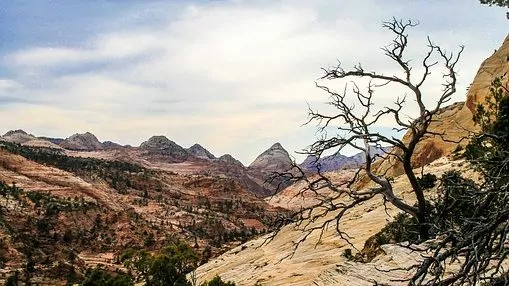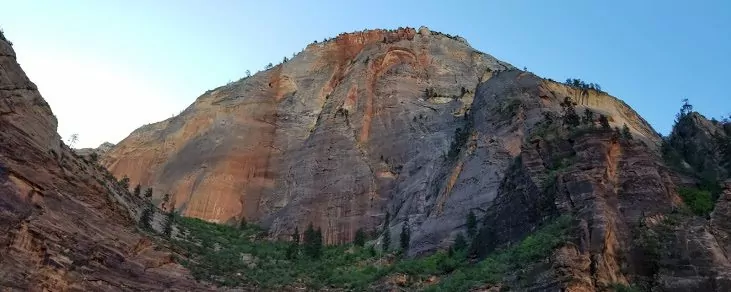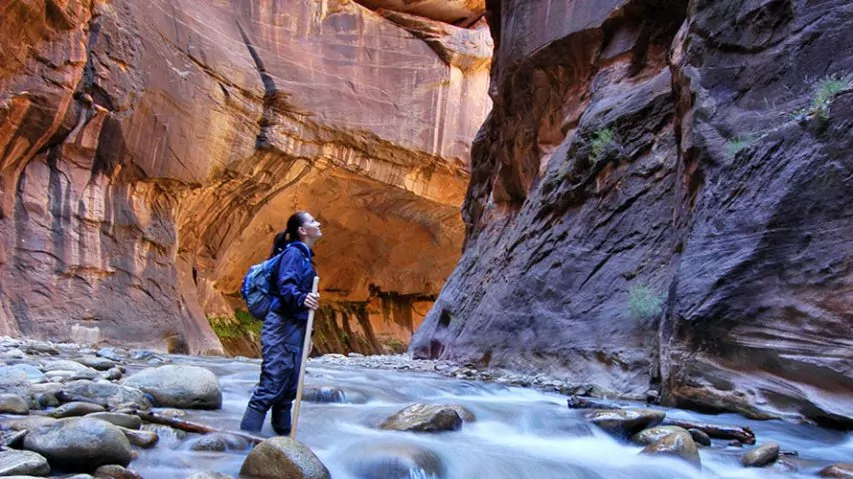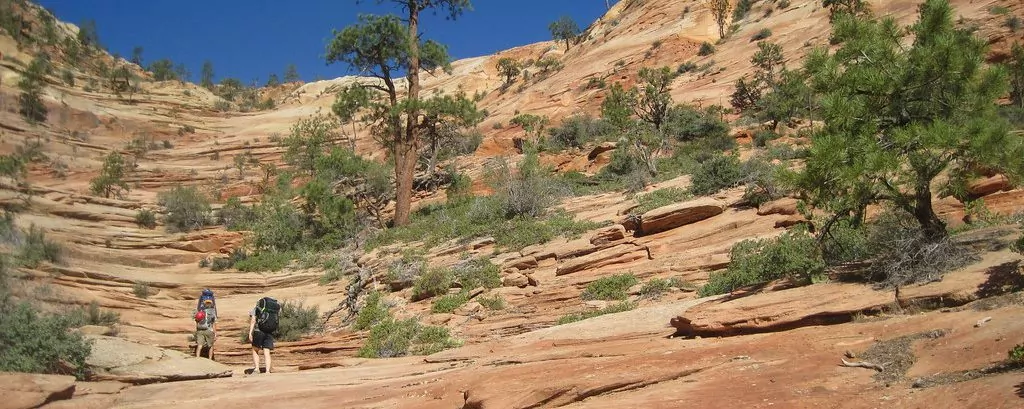
East Rim Trail
General Description
The East Rim Trail is great as a long day hike option or as a leisurely backpack. Hikers can start at the Observation Point trailhead and climb over 2000 feet to the top of the plateau or begin at the east entrance to Zion National Park an descend into the canyon. Either way, you are treated to breathtaking views of Zion Canyon and the other-worldly coliseum of Echo Canyon. If you choose the backpacking option, be sure to take time to explore the spur trails to Deertrap and Cable Mountains for some seldom visited canyon-edge vistas. All overnight trips in Zion National Park require a wilderness permit obtained at the Zion Wilderness Desk. Don’t forget to arrange a shuttle if you are through-hiking this trail. CLICK HERE for more information on shuttle services in Zion National Park.
Explore Zion with Expert Guides
Getting to the East Rim Trailhead
There are two ways to start the East Rim Trail. If you are completing this trail as a thru-hike, don’t forget to arrange a shuttle. There are plenty of great backpacking shuttle service options in Springdale, UT. The easiest, and most popular way to hike this trail is starting at the east entrance to Zion National Park. To reach this trail head from the Zion Visitor Center, follow UT State Highway 9 for 11.5 miles east to the trail head parking on the left near the east entrance kiosk. From Mt. Carmel-Junction, UT, follow UT State Highway 9 west for 13 miles to the trail head on the right.
History of the East Rim Trail
It is difficult to fathom that the East Rim Trail started as a single faded track used by the native peoples of Zion Canyon to access the high plateau rim. However,the extremely observant hiker can see evidence of its use through the centuries still carved into the smooth rock faces. Presently, moki steps (steps carved out of the rock by native peoples hundreds of years ago) are still visible on the steeper parts of the trail. In 1896 a local rancher improved the primitive trail to gain access to the higher elevation grazing grounds found on the eastern rim of the plateau. The trail was further improved some years later to access the cable draw works at the top of Cable Mountain. The National Park Service improved the trail that we know today in its fledgling years from 1918-1919.

3 Best Day Hikes on the East Rim Trail
There are several great day hiking options on the East Rim Trail. All of them are longer day hikes and most suitable for experienced hikers.
Below are the primary options for day hiking the East Rim Trail. All of these options start at the Weeping Rock Trailhead in Zion Canyon:
| Destination | Miles | Elev | Difficulty | Style | |
| Observation Point | 8 mi | 2000 ft | Moderately Strenuous | Out and Back | |
| Cable Mountain | 15.5 mi | 2100 ft | Strenuous | Out and Back | |
| Deertrap Mountain | 17.5 mi | 2100 ft | Strenuous | Out and Back |
1. Observation Point Trail
The hiking trail to Observation Point is one of the most challenging and rewarding day hikes in Zion National Park. At 8 miles round trip, your legs and lungs will certainly get a solid workout. Along the way, hikers catch sneak peaks into the alluring slot sections of Echo Canyon and the sheer walls of Cable Mountain. The trail leaves Echo Canyon and opens into the slick rock wonderland of the park’s upper east side. This hike conquers over 2000 vertical feet of solid sandstone and is chiseled into the side of the canyon walls offering dramatic views out into the main canyon. Day hiking the Observation Point Trail is a great way to enjoy some of the best views of Zion Canyon while towering 700 feet above the more popular Angel’s Landing Trail.
2. Cable Mountain Trail
A spur trail off the East Rim Trail, the hike to Cable Mountain takes hikers to a remote and beautiful view point in Zion Canyon. From the parking lot at Weeping Rock, look up at the top of the imposing Cable Mountain directly ahead. Slightly left of the top are the remaining timbers of the cable draw works that once delivered hundreds of thousands of board-feet of lumber from the high plateaus to the canyon floor. The trail begins a little over 4 miles along the East Rim Trail from the Weeping Rock trail head. Wind your way up from the canyon floor, through the twisted passage of Echo Canyon, and across the sea of slick rock leaving the main Observation Point Trail. The final 3 mile approach across the top of the plateau takes you to the cable works ruins and to a seldom-seen view of Zion Canyon.
3. Deertrap Mountain Trail
The effort hikers pour into hiking to Deertrap Mountain is rewarded by blissfully undisturbed views of Zion Canyon. This unrelenting uphill hike winds through the water-sculpted walls of Echo Canyon, across the beautiful slickrock of the East Rim Trail, and through the wildflower-dotted flats of the upper plateau. The final approach to the viewpoint of Deertrap Mountain offers stunning views from the rim of the canyon floor over 2000 feet below. Very few hikers make this trek, so solitude is just about guaranteed. The price you pay will be burning legs and knees from the extreme distance and elevation gain and loss. Be sure to take plenty of water, know your route, and be safe.
Maximize Your Visit to Zion National Park on a Hiking Tour
Guided day hike tours and multi-day packages allow visitors the opportunity to make the most of their time in Zion National Park and to do it hassle-free. Guided tours include gear (backpack, trekking poles, crampons in winter), meals, accommodations on multi-day tours, local transportation, and a professional Utah hiking guide. Through their knowledge, stories, and personal passion, guides can bring a place to life in a way that’s much more difficult to do on your own.
Award Winning USA Hiking Vacations

3 Nearby Backpacking Trips
While the East Rim Trail is a great backpacking option, there are plenty of other backpacking options nearby. Here are a few of the best.
| Route | Miles | Elevation Gain/Loss | Difficulty | |
| West Rim Trail | 16-18 mi | -3400 ft | Moderately Strenuous | |
| Zion Narrows (Top Down) | 15-18 mi | -1500 ft | Strenuous | |
| The Zion Traverse | 47 mi | +4000 ft, -4500 ft | Strenuous |
1. West Rim Backpacking Trip (2 days)
The West Rim Trail is the big brother to the East Rim Trail. It starts at 7900 feet and descends to the canyon floor over 3400 feet below. The beauty of the West Rim Trail is that the scenery builds into a crescendo of canyons and towers. Starting at Lava Point, hikers are treated to a grand overview of the canyon-riddled landscape of Zion National Park. The descent meanders through jaw-dropping views into the Left Fork of North Creek and the Great West Canyon. The wide, exposed trail snakes down to Scout’s Lookout to join the Angel’s Landing Trail. All the while, the whole of Zion Canyon lays at your feet. Take time on your final day to make the half mile hair-raising hike to Angel’s Landing Viewpoint.
2. Zion Narrows Backpacking Trip (2 days)
Hiking the Zion Narrows from start to finish is, hands down, the best way to experience this amazing canyon. Hikers will experience the blossoming of a canyon as the subtle forested drainage gives way to the deep, mystical narrows that Zion is known for. The trail follows the river course between ever deepening canyon walls in the cool waters of the North Fork Virgin River. Several large boulder fields, waterfalls, and log jams add a sense of extraordinary adventure to the already unbelievable hike. Backpacking through this iconic canyon allows hikers to immerse themselves in it’s full majestic beauty and mystery. Best of all, the final miles of the hike pass through the deepest, narrowest sections of the canyon. This is truly a magnificent backpacking trip, but it is very popular. Few permits are issued for this hike, and it is in high demand.
3. Zion Traverse Backpacking Trip (3-5 days)
The Zion Traverse is the mother of all backpacking trips in Zion National Park. This masterfully crafted trek strings together a series of trails from the far northwest corner of the park to the far southeastern edge. The Zion Traverse is the quintessential way to experience everything Zion National Park has to offer. Take the spur trail to Kolob Arch, the second largest arch in the world. Stroll through the quiet, forested plateaus of Zion’s West Rim. If you’ve got time and nerves of steel, take the harrowing side hike out to Angel’s Landing viewpoint. Finally, take in the rugged beauty of Zion’s East Rim as you conclude your traverse. Keep in mind that you will need to arrange a shuttle for this incredible thru-hike.
Join a Guided Zion National Park Trip
Joining a backpacking tour near Zion National Park is a worry-free, adventurous way to experience Southern Utah. With your gear, meals, local transportation, permits, and fees taken care of for you, you can travel light and focus 100% on enjoying the hiking experience, while the guide company takes care of everything else. Also, by going with local experts you’ll enjoy a greater level of safety and gain a much better understanding of the history and ecology of this remarkable region. Read more about a guided backpacking trip near Zion National Park.
All-inclusive Utah Backpacking Adventures

When to Hike and Seasonal Considerations
The East Rim Trail is best hiked the spring and fall. In winter, the top of the plateau can be snow-covered and difficult to access. Additionally, the Zion Canyon Shuttle is not always running during the winter and can add difficulty to shuttle logistics. If you are hiking this trail during winter, be sure to carry traction devices in case of snow and ice on exposed parts of the trail. During the summer, daytime temperatures can make hiking difficult on the flat, exposed plateau tops. If you are completing the through hike, don’t forget to arrange a shuttle.
Necessary Permits
Day Hike Permits
No permits are needed to day hike the East Rim Trail.
Backpacking Permits
Permits are required for all overnight trips in Zion National Park. Hikers can apply for permits 3 months in advance on the 5th of each month. There is a $5.00 non-refundable fee for an online calendar reservation, and there is an additional charge for a permit that is determined by the size of your group. About one third of backcountry permits can also be obtained the day before or day of a trip by walk-up only. For more information on Zion National Park’s permit system, click here.
Suggested Packing List
Day Hike Packing List
- 3-4 liters of water per day (more in summer)
- Salty, calorie-rich snacks
- lunch
- backpack
- trekking poles
- crampons (in winter)
- wide-brimmed hat
- sunscreen, sunglasses
- cotton t-shirt (spring-fall)
- non-cotton t-shirt (winter)
- rain jacket
- warm non-cotton layer
- 1st-aid kit
Backpacking Packing List
- all items listed for day hikes PLUS
- multi-day backpack
- 3-season tent
- sleeping bag
- sleeping pad
- backpacking stove and fuel
- backpacking meals
- 2-3 pairs wool socks
- extra t-shirts
Please Respect Our National Parks – Leave No Trace
We strongly recommend abiding by all Leave No Trace ethics guidelines and practices so that our national parks and public lands are preserved for the enjoyment of future generations and for the people and animals who call these places home. Simple things like packing out your trash, obeying national park rules, and respecting the peace and quiet of our national park trails is a great start. If you’re going on a backpacking trip, you can read about more about the 7 Leave No Trace Principles.





